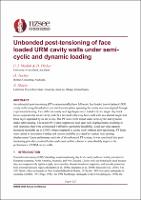| dc.contributor.author | Maduh, Uchenna J. | |
| dc.contributor.author | Tocher, Hamish | |
| dc.contributor.author | Slavin, Nicholas | |
| dc.contributor.author | Dizhur, Dmytro | |
| dc.date.accessioned | 2020-06-18T13:53:55Z | |
| dc.date.available | 2020-06-18T13:53:55Z | |
| dc.date.issued | 2020-04-22 | |
| dc.identifier.uri | https://repo.nzsee.org.nz/xmlui/handle/nzsee/1733 | |
| dc.description.abstract | An unbonded post-tensioning (PT) system installed into full-scale face loaded (out-of-plane) URM cavity walls using threaded rod and steel anchor plates spanning the cavity was investigated through experimental testing. Two different cavity wall typologies were tested: (1) two single clay brick leaves separated by an air cavity and (2) a two-leaf solid clay brick wall with an external single leaf brick layer separated by an air cavity. The PT walls were tested under semi-cyclic and dynamic shake-table loading. The tested PT system suppressed mid-span wall displacements, resulting in wall responses that were constrained well below geometric instability. Load-carrying capacity increased markedly up to 1500% when compared to cavity walls without post-tensioning. PT loads were varied to determine whether rod tension could be activated by vertical wall arching displacement. Upon preliminary analysis of the unbonded PT system, it was concluded that post-tensioning provides a cost-effective and constructible solution to considerably improve the performance of URM cavity walls. | |
| dc.language.iso | en | |
| dc.publisher | New Zealand Society for Earthquake Engineering | |
| dc.relation.ispartofseries | 2020;122 | |
| dc.subject | Advances in earthquake engineering research | |
| dc.title | Unbonded post-tensioning of face loaded URM cavity walls under semi-cyclic and dynamic loading | |
| dc.type | Article | |

